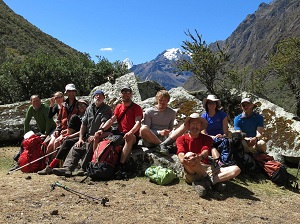Overall this was a highly successful and harmonious expedition that was blessed by excellent weather.
By Derek Buckle, expedition leader.
After gathering together in Lima, the sprawling capital of Peru, we travelled in style by private limo to Huaraz, the climbing capital of the Cordillera Blanca. At 3,100m Huaraz was something of a shock to the system and we spent two days acclimatising there before transferring to base camps in one of two distinct valleys. The first day was easy – a visit to the hot springs at Chancos – but was followed by a more demanding walk up Q. Shallap to the attractive, emerald green Laguna Shallap, nestling at 4,250m.
Our first foray was to Q. Quilcayhuanca where the primary targets were San Juan (5,843m) and Chinchey (6,309m), which we hoped to attempt after further acclimatisation. Fortunately both Quilcayhuanca and its side valley, Cayash, offer plenty of more readily accessible objectives, which was a blessing considering the lean snow conditions this year. Following a few exploratory forays by various members of the team, Chris & Phil successfully climbed Quimarumi (5,455m) via its NE ridge while Dave, Melanie & Rafal persevered on steep scree before finally reaching the attractive summit of Chopiraju (5,518m) via its S face and W ridge. From a high camp Dave, Derek, Melanie & Rafal then climbed Jatunmontepuncu (5,421m) via its S ridge and this peak subsequently became the focus of Chris & Phil and Nick B & Catriona, who completed the round trip in a single day from base camp.
With youth and determination on their side, Chris & Phil were the only pair to successfully climb Chinchey, which they managed in a very long day via the W face after finding the normal route on the N ridge inaccessible. Both Nick B & Catriona and Nick K & Derek climbed to the high glacier camp but were deterred from continuing on account of either unattractive conditions or the effort involved. Before returning to Huaraz (where Nick B, Catriona and Melanie departed), most members of the team climbed Maparaju (5,424m), ascending via its SW and W slopes.
The second foray was to Q. Ishinca, where Tocllaraju (6,032m) was the key objective. After positioning a high camp on the glacier Chris & Phil climbed the challenging W face while Dave, Derek, Nick K & Rafal ascended via the NW ridge. For many this was the highlight of the trip, but we had hoped to attempt Ranrapalca (6,162m) before returning home. Prudence dictated against this as the NE face was in a dangerous condition, so we consoled ourselves with the classic traverse of Ishinca (5,530m), climbing the NW slopes and descending via the SW ridge before finally leaving for Huaraz.
Overall this was a highly successful and harmonious expedition that was blessed by excellent weather.
Participants: Nick Berry, Dave Broadhead, Derek Buckle (Leader), Catriona Clusas, John Hudson, Nick King, Phil Leadbeater, Rafal Malczyk, Chris Petrauska, Melanie Windridge






